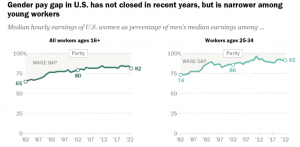For decades, Diversity, Equity, and Inclusion (DEI) initiatives have played a pivotal role in advancing gender equity in workplaces and educational institutions. These programs, designed to reduce systemic barriers, have contributed to increased female representation in leadership, narrowed wage gaps, and fostered inclusive work environments. However, with growing efforts to eliminate DEI programs, the question arises: What will the absence of these initiatives mean for women?
As policymakers and business leaders move away from structured DEI efforts, research suggests that women—particularly women of color—stand to lose significant progress in professional and academic opportunities. Eliminating DEI policies could weaken the mechanisms that help counteract gender bias, leading to wider pay gaps, reduced career mobility, and increased workplace discrimination.
DEI’s Role in Workplace and Educational Equity
DEI initiatives have been instrumental in addressing gender disparities in hiring, promotions, and leadership representation.
Our latest analysis reaffirms the strong business case for both gender diversity and ethnic and cultural diversity in corporate leadership—and shows that this business case continues to strengthen. The most diverse companies are now more likely than ever to outperform less diverse peers on profitability.
Our 2019 analysis finds that companies in the top quartile for gender diversity on executive teams were 25 percent more likely to have above-average profitability than companies in the fourth quartile—up from 21 percent in 2017 and 15 percent in 2014 (Exhibit 1). (McKinsey & Company 2020).
Without these programs, businesses may inadvertently reinforce existing biases, limiting opportunities for women to advance.

Similarly, in education, policies such as Title IX, which mandates gender equity in federally funded programs, have significantly increased women’s participation in higher education and athletics. According to the American Medical Association, women now make up 36 percent of America’s physician workforce, compared to just 6 percent in 1950. And for the first time in history, 2017 saw more women entering medical school than men. (AMN Healthcare) Scaling back DEI efforts could erode these hard-won gains, particularly for underrepresented women in STEM and executive roles.
The Wage Gap and Economic Consequences
Despite progress, women still earn 82 cents for every dollar earned by men, with Black and Latina women earning even less—64 cents and 57 cents, respectively (National Women’s Law Center). DEI initiatives help combat these disparities by promoting pay transparency, salary audits, and mentorship programs that support women’s career growth. Research from the Harvard Business Review highlights that companies with structured DEI policies see narrower wage gaps and higher retention rates among women (Huang et al. 2022).
Eliminating DEI programs removes accountability, allowing salary inequities to persist unchecked. Without systemic measures in place, the burden of negotiating fair wages and career advancement will fall solely on individual women, who already face documented biases in salary negotiations and promotions.

Workplace Culture and the Risk of Regression
Beyond salary and career advancement, DEI programs have played a role in improving workplace culture, safety, and flexibility, addressing issues such as sexual harassment, parental leave, and work-life balance. Research from the Pew Research Center found that companies with DEI policies were more likely to provide paid maternity leave, flexible work arrangements, and sexual harassment training—all of which contribute to higher job satisfaction and lower turnover rates among women (Pew Research Center 2022).
Without these initiatives, women may experience increased discrimination and fewer institutional protections. A 2023 report from Lean In states, “For women with traditionally marginalized identities, these slights happen more often and are even more demeaning. As just one example, Asian and Black women are seven times more likely than white women to be confused with someone of the same race and ethnicity.” without DEI policies, these issues risk being ignored rather than addressed (Lean In).
The Myth of Meritocracy
Critics of DEI initiatives often argue that workplaces should operate on a merit-based system rather than structured diversity policies. However, studies indicate that bias, not merit, often determines hiring and promotion outcomes. A Yale University study found that identical resumes with male names were rated as more competent and offered higher salaries compared to those with female names (Moss-Racusin). This suggests that simply removing DEI efforts does not create fairness; rather, it allows existing biases to persist. Not only do males benefit for simply through their name, it has been revealed white women have been a primary beneficiary of DEI efforts. in a Linked In article, Aparna M. shares
“The data is clear – over the past 10 years – white women not only hold the majority of executive roles (75-80%) but are also the best compensated for this work, with the longest tenures. Even as budgets have been slashed and women of color (in particular, Black women) have left organizations, there have been few high-profile exits of white DEI leaders over the past year…Harvard Business Review found that “concentration of demographic groups in decision-making roles can subtly shape agendas and priorities to be more aligned with their experiences and needs, which may exclude or marginalize others.” DEI programming is being shaped by a group of people who have homogenous networks. (Aparna M.)
Without access to major databases and official channels, Aparna was able to identify a deeper issues over one year prior to the current political shift we are witnessing today. It goes without saying that DEI initiatives have not been properly allocated amongst all of the groups it was legalized to protect and empower with equitable opportunities based on their skill set and not friends in high places.
What Comes Next?
If DEI programs are eliminated, organizations and institutions must consider alternative strategies to maintain gender equity and workplace fairness. Steps such as pay transparency, structured mentorship programs, and bias training can help uphold progress. However, relying solely on voluntary corporate or institutional efforts—rather than structured policies—risks a return to exclusionary practices that hinder women’s economic and professional mobility.
Final Thoughts
DEI initiatives have not been perfect, but they have been crucial in shaping a more equitable society. Removing these policies could widen gender disparities, making it harder for women to achieve leadership roles, close the wage gap, and work in inclusive environments. The question is not just whether DEI should exist, but whether we, as a society, are willing to risk undoing decades of progress in gender equity.
As discussions about DEI unfold, policymakers and businesses must consider the long-term implications of eliminating these initiatives. Without them, the fight for gender equality may become an uphill battle once again.

